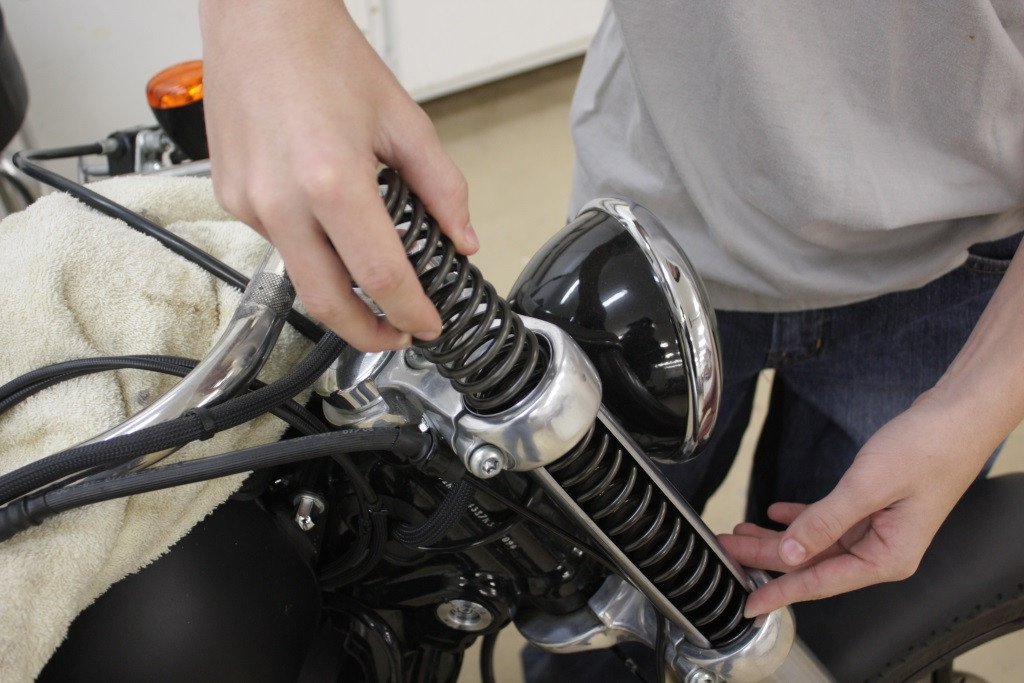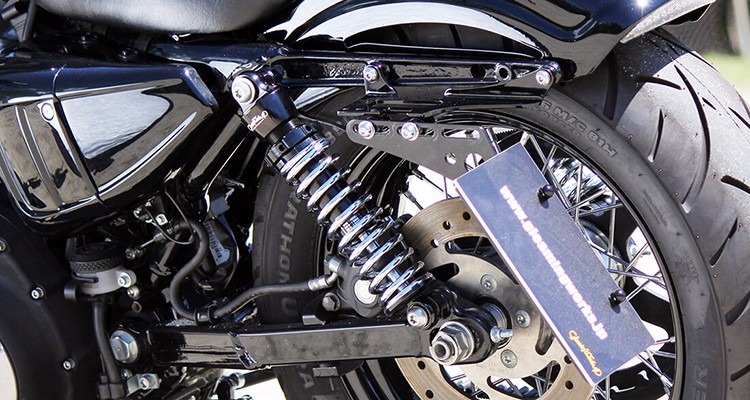The way the motorcycle behaves will depend on the effectiveness and proper functioning of its suspension system, which is why it is so important to check it every so often.
On an ordinary motorcycle, the front suspension has a fork composed of a pair of fork tubes or bars, and the rear, an arm with one or two shock absorbers.

From there, we can find in the market endless designs of suspensions, which each brand understands in its own way. They are called suspensions because they contain a part of the motorcycle that is suspended on the wheels.
If you have a custom motorcycle, not only for aesthetics, but for you to move as safely as possible, you should understand how the suspensions work, as well as the behavior in the different types of terrain before deciding.
To start, you have to be aware of the work according to the motorcycle's weight distribution. In the braking maneuver, the total weight is concentrated on the front wheel, while the rear wheel is responsible when we accelerate.
To achieve balance in the process, suspension is vital, which acts to compensate for the ups and downs that occur when we are driving. Thus, the tires will gain in adherence to the ground, offering a much safer driving.
Likewise, the way to behave the suspension of a motorcycle will depend on the load that it carries, so we must be especially cautious when we ride with a passenger. The firmness of the motorcycle depends on the balance of the suspension and therefore the safety, hence its importance.
On the other hand, knowing the components of the front and rear suspensions will help you understand the operation of the system, which we will explain briefly.
Preload: This is the pressure at which the spring is subjected when we are driving or even if we are standing on the motorcycle. This function will determine the height at which the suspension will work and can be adapted according to the needs of each pilot and the type of terrain.
Extension: It is the speed with which the spring returns to its resting position after stretching after having shrunk in a movement. This force is given by the hydraulic shock absorber that controls the return of the spring, opening and closing the valves. There are motorcycles that allow adjusting the suspension, by regulating lubricant inlet. The more oil passes, the faster the extension will occur.
Compression: It is the opposite process to the extension, that is, the speed with which the fork or the rear shock absorber contracts. The harder the compression, the stronger the movements, although it is not convenient that it is too soft, it would cause a succession of bounces that are not pleasant or safe.
Both the fork and the rear shock follow the same basic principles, although they differ in the shape of their components.
The most extended form of fork is the telescopic with hydraulic shock absorber. It has a pair of bars that slide inside the bottles, a spring and a damping system based on the circulation of oil.
Other prominent forks are the inverted one, which uses the same system as the telescopic but on the contrary; those of parallelogram, which consist of two double bars attached to the wheel axle by the end of a tilting plate and with springs at the top; and the Springer or springs, which has a double damping system determined by a large central spring in addition to the lateral ones.
The rear shock absorber, meanwhile, consists of body and spring. The body is formed by a rod and a perforated piston, which works to soften the return, while the spring is responsible for elastic movement, providing resistance to compression.

At the end of the shock absorber cylinder there is a movable wall with seals, whose purpose is to prevent the oil pressure from rising due to the introduction of the stem. On the other side, the nitrogen is placed under pressure, so that when it raises its temperature it increases its volume, acting as an oil pressure regulator. This will be responsible for pushing the movable wall and compressing the gas.
As we said above, each brand understands in particular the suspension. The Carbon system, which takes its name from its inventor, is what most modern suspensions have. In it, the oil moves through a predetermined circuit inside the body, and its situation varies depending on the shock absorber.
It is quite functional, but has its limitations. The ‘vegija’ or ‘bladder’ (a rubber membrane whose function is to expand or reduce depending on the oil / nitrogen in the tank) tends to dilate and can cause bubbles to occur. Only by removing the used oil and replacing it with a new one, will the shock absorber return to work in perfect condition.
Precisely in order to eliminate the limits of this basic system, different brands work. From there, double-tube shock absorbers have emerged, such as the new Öhlins TTX. In this system, the gas flows better thanks to the pressurization in the middle of the process. Compression and extension regulators are located at the top, while the oil circulates in a circular manner, which is recycled during the circuit.
Another solution has found firms such as Kayawa and Showa, which have contributed a gas pump or 'bypass'. When the fork is compressed, the oil inside the bar passes through the regulator and is then rescued by the pump, which helps you find the return valve when the fork reopens.
Having a good set-up of the suspensions will allow us to travel more safely on the behavior of our motorcycle. For this, the key is to make a proper adjustment.
The adjustment takes into account the functionality of several components: spring, blades, piston, needle and adjustment clicks. It is a demanding operation, which requires experience, so the best decision is to have a professional mechanic. So you can enjoy safe driving on two wheels, over the bumps and irregularities of the road.




